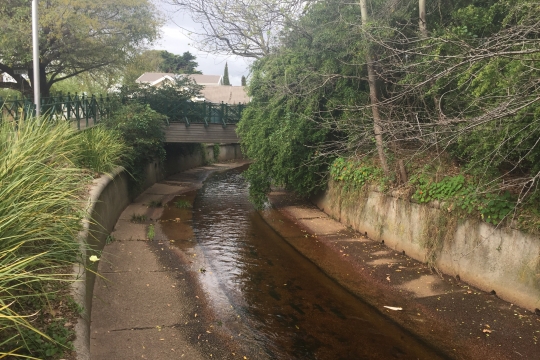If Cape Town’s urban surfaces are designed to be porous and water-catching, it could help meet many of the city’s water needs through recharging the Cape Flats aquifer, while also helping to manage rainy season flooding and stormwater pollution challenges.
The urban landscape here has considerable potential as a water catchment for the aquifer that sits beneath it, with about double the municipality’s current water needs falling as rain across the Cape Flats, suburbs, and central city area, according to Dr Kevin Winter, with the University of Cape Town’s Environmental and Geographical Sciences unit.
But now that the city has been developed so extensively, hard surfaces like paved roads and parking lots, and highly engineered stormwater systems, become an impermeable skin which transport water away from aquifer recharge points, and prevent rainwater from percolating into the soil and the ground water storage areas beneath the surface.
A redesign of parts of the city surface could allow greater rainfall recharge of the Cape Flats aquifer, which could then be abstracted to meet the population’s growing need for potable water.
According to Winter, the aquifer could be a significant source of underground water if it is carefully managed and monitored. A 2010 article in the journal Water SA states that the aquifer could supply about 5% of the city’s water needs, at the rate of water use in 2016, before the city imposed water restrictions in relation to the current drought. However, Winter says that at current drought restriction usage levels, it could supply as much as a third of the city’s current water needs.
‘This aquifer is like a massive underground dam. It extends about 450 square kilometres from Table Bay to the west, across the airport industrial area to to Sir Lowry’s Pass on the west, and south to False Bay coastline, and as far as the Tygerberg Hills in the north,’ says Winter.
Current surface water storage solutions in the Cape, such as dams, can lose as much as 18% of their water during summer, owing to evaporation. Water stored in the aquifer is protected from this sort of loss.
An article in the online magazine Fast Company this month argues for an overhaul of how cities currently handle stormwater runoff. Most cities manage rainwater by building hard-engineered infrastructure that channels water into underground pipes and sewers, which send it ’as far and fast away from streets and buildings as possible and discharge that runoff into a larger body of water’, writes Diana Budds.
The environmental problems resulting from this sort of engineering are common in parts of the city and on the Cape Flats: flooding from an overwhelmed system, fast-moving water which can damage soil and infrastructure, and the collection of pollutants. Budds says these highly engineers systems also prevent aquifer recharge, which can lead to the ground subsiding.
Instead of building systems that try to remove water quickly, and across distances, Budds argues that cities should be redesigned to keep rainwater ‘close to the site where it lands’. This will alleviate the pressures on stormwater infrastructure. Cities can do this by putting in ‘green infrastructure’ such as infiltration ponds, rain gardens, and bioswales. Bioswales are landscaping features that are designed to slow water down, pool it, and allow it to percolate into the ground. Permeable pavements, open spaces, and green roofs are also part of this ‘green infrastructure toolkit’.
‘The more of these natural systems cities adopt, the less they have to rely on heavy engineering, which can fail, requires maintenance and constant upkeep, and is expensive to operate.’
Budds also points out that much of the existing stormwater infrastructure in modern cities has been designed to meet the specifications of a system that ‘is now in flux, as climate change makes rainfall and storms less predictable’.
UCT’s Dr Kevin Winter recently told Earthworks magazine that the city needed to consider maintaining undeveloped green open spaces such as the Philippi Horticultural Area within the wider city-scape, as these natural systems can help to ‘climate proof’ the city.
‘The ecosystem services provided by green open spaces help to recharge the aquifer, soften the extremes of heat waves and droughts, and slow the impact of flooding,’ Winter explains.
However, once areas are covered over with hard surfaces, such as roads and concrete paving, it is expensive and difficult to reverse-engineer the city back towards a more stormwater-friendly system as described by Budds.
Meanwhile the South African Academy of Engineering will host civil engineering professor Mike Muller at a public lecture on 2 November. In light of the City of Cape Tow’s current water crisis, Muller will discuss how the engineering profession can transform as society faces the engineering challenges of the coming century.
